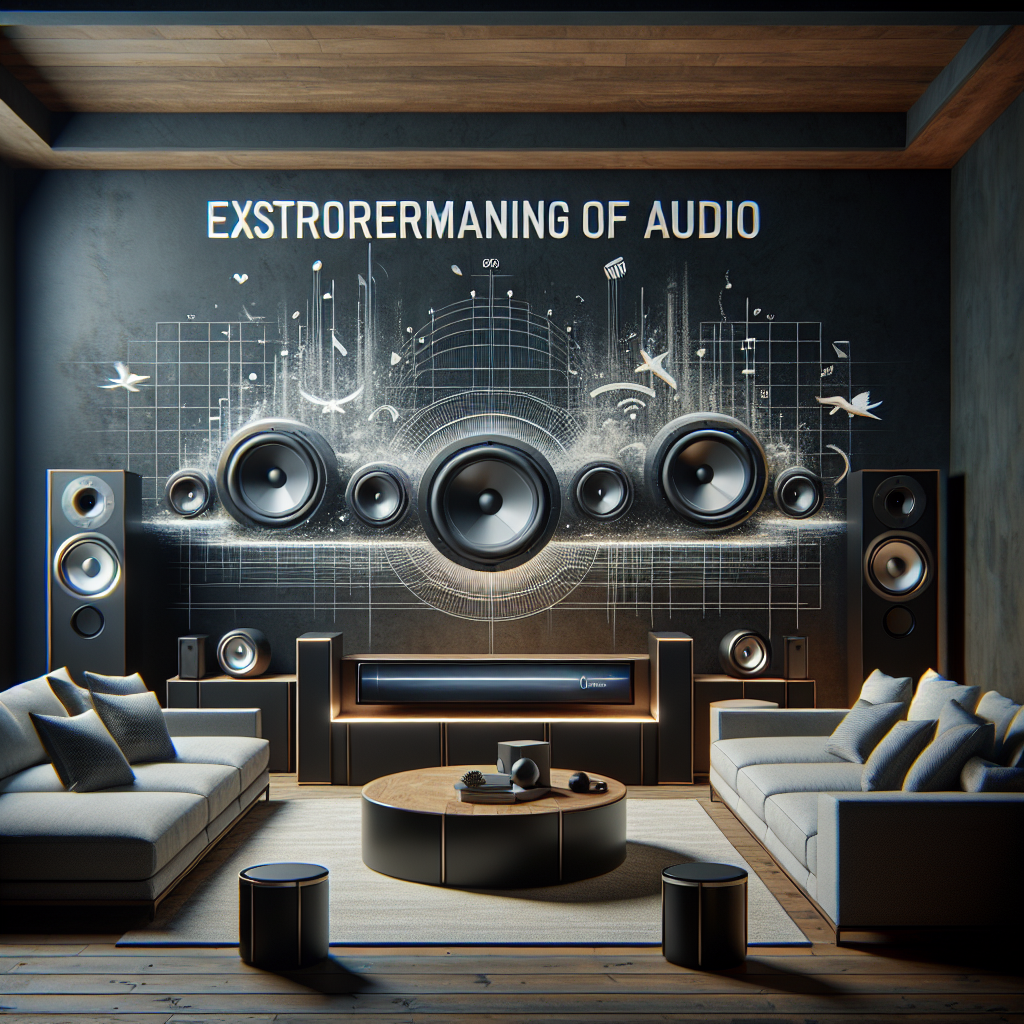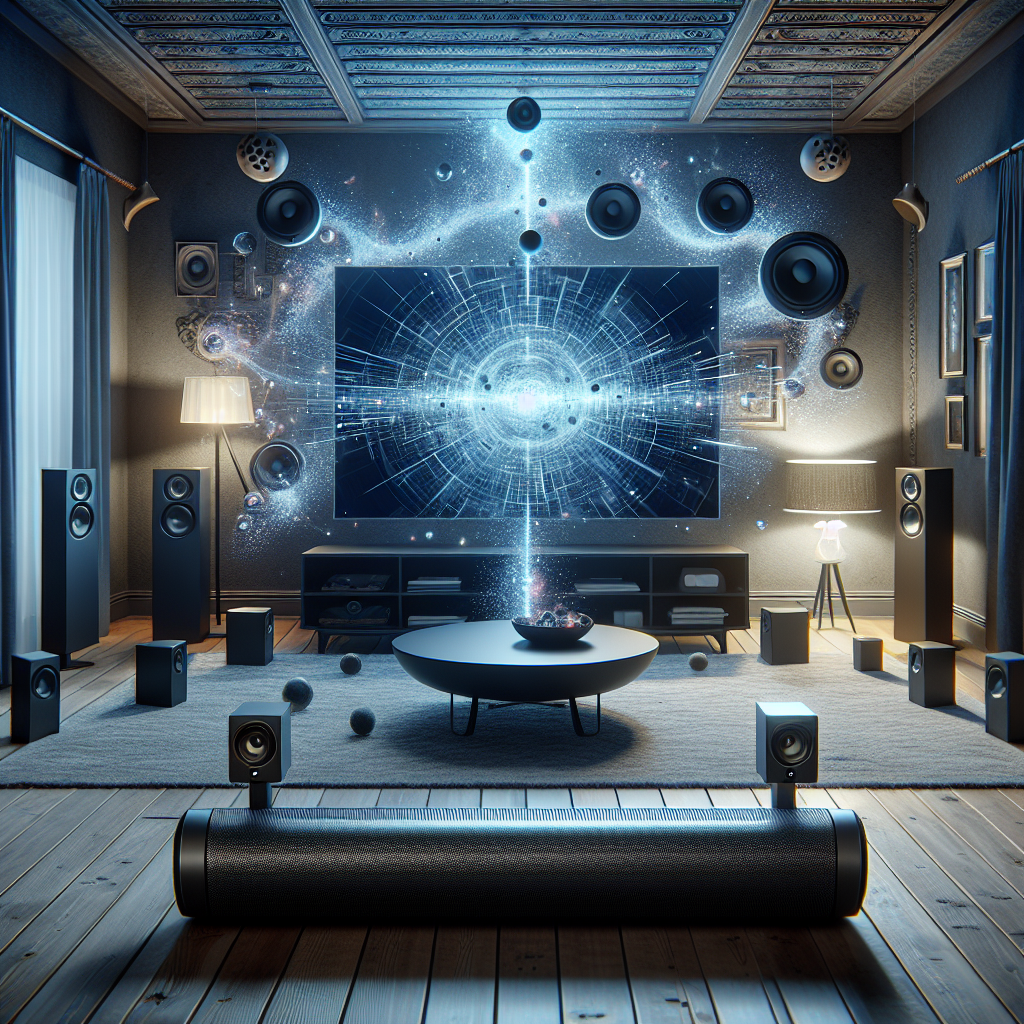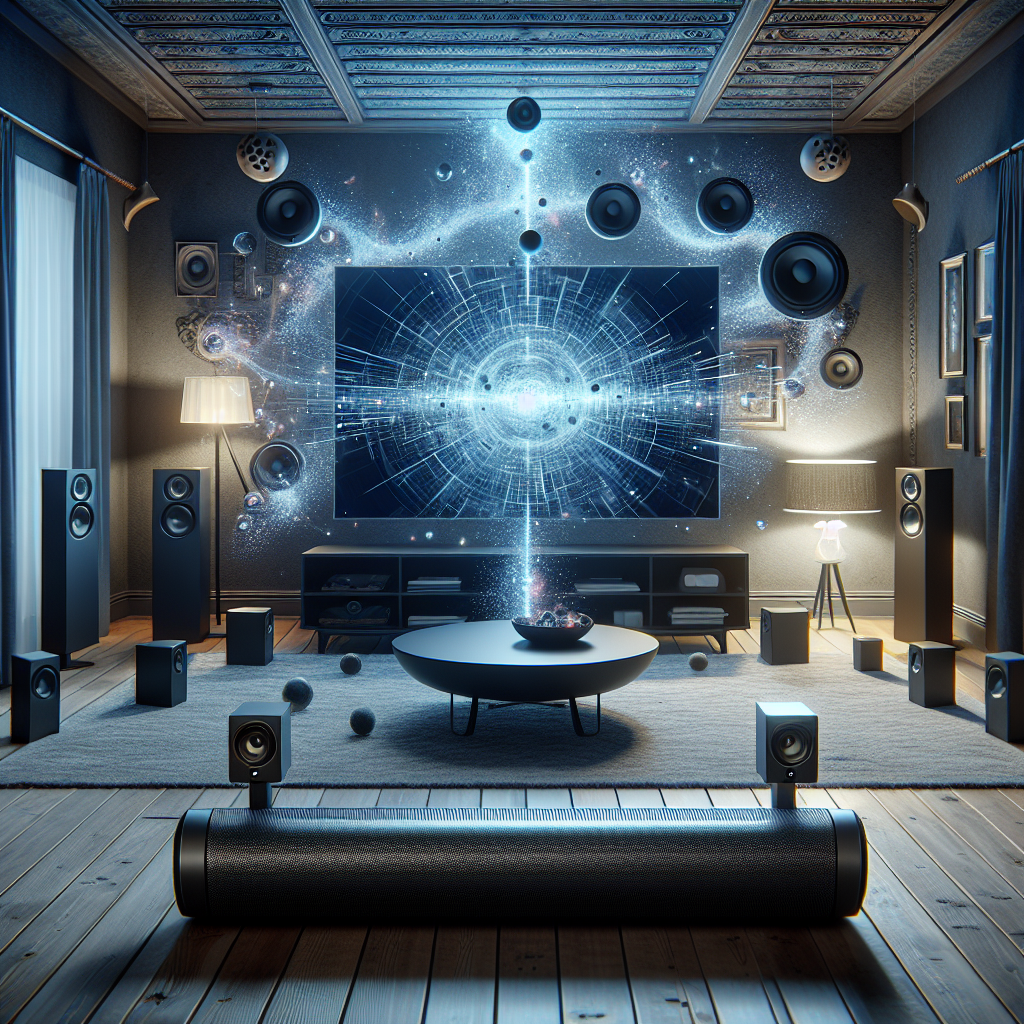Imagine stepping into your favorite movie or concert from the comfort of your own living room. With the latest advancements in home sound systems, this is now possible. Whether you’re a film enthusiast or music lover, immersive audio experiences can transport you into a world of breathtaking sound. Gone are the days of settling for ordinary sound quality; these home sound systems offer a whole new level of realism and depth. From powerful surround sound speakers to cutting-edge technologies, your senses will be truly captivated by these immersive audio experiences. Get ready to be blown away by the extraordinary soundscapes that await you.

Choosing the Right Home Sound System
When it comes to choosing the right home sound system, there are a few key factors to consider. The first and foremost is your budget. It’s important to determine how much you are willing to invest in a sound system for your home. This will give you a clear idea of what options are available to you within your price range.
Once you have set your budget, the next step is to evaluate your space. Consider the size and layout of the room where you intend to set up your sound system. This will help you determine the number of speakers you’ll need and whether a larger system or a more compact one will be suitable for your space.
With your budget and space in mind, it’s time to research different brands and models. Take some time to read up on the various sound systems available in the market. Look for features that align with your preferences, such as wireless connectivity or compatibility with your existing devices. Pay attention to the specifications and capabilities of each model to ensure they meet your expectations.
To further aid in your decision-making process, reading reviews and customer testimonials can provide valuable insights. Hearing what others have to say about their experiences with specific home sound systems can help you gauge the quality and performance of a product. Take note of both positive and negative feedback to make an informed decision.
Understanding Surround Sound Technology
Surround sound technology is the key to creating an immersive audio experience in your home. It involves the use of multiple speakers strategically placed around the room to replicate the sensation of sound coming from different directions. This creates a three-dimensional audio environment that enhances the viewing or listening experience.
There are different types of surround sound systems to choose from, each with its own setup and speaker configuration. The most common ones include 5.1, 7.1, and Dolby Atmos. A 5.1 system typically includes five speakers and one subwoofer. A 7.1 system adds two additional speakers for a more immersive audio experience. Dolby Atmos takes it a step further by incorporating height speakers or ceiling-mounted speakers for a truly immersive overhead sound experience.
There are several benefits to investing in a surround sound system for your home. Firstly, it greatly enhances the audio experience when watching movies or TV shows, making you feel like you’re right in the middle of the action. It also adds depth and dimension to music, bringing out details that might otherwise go unnoticed. For gamers, surround sound can provide a competitive edge by allowing them to pinpoint the location of in-game sounds with greater accuracy.
Setting Up Your Home Sound System
Once you have chosen the perfect home sound system, it’s time to set it up for optimal performance. One important aspect of setup is optimizing the placement of speakers. Proper speaker placement is crucial for achieving the desired sound quality and imaging. Consider the manufacturer’s recommendations and experiment with different positions to find the setup that works best for your space.
Calibrating audio settings is another crucial step in setting up your home sound system. Most sound systems come with built-in calibration tools that help adjust the audio output to suit your room’s acoustics. Take the time to go through the calibration process and fine-tune the settings to achieve the best sound quality possible.
The next step is connecting devices and sources to your sound system. This can include your TV, gaming console, streaming devices, and music players. Ensure that you have the necessary cables and connections for seamless integration. Consider using HDMI or optical cables for digital audio transmission, as they offer higher quality and more reliable connections.
Once everything is set up, it’s essential to test the sound system to ensure it’s functioning as expected. Play different types of content, such as movies, music, and games, to verify that the audio is clear, balanced, and immersive. Make any necessary adjustments to the settings or speaker placement based on the test results.
Exploring Audio Formats and Media
To fully appreciate the capabilities of your home sound system, it’s important to understand different audio formats. Dolby Atmos and DTS:X are two popular formats that deliver immersive audio experiences. Dolby Atmos, in particular, introduces height channels, allowing for more precise localization of sounds and a truly enveloping audio experience.
When it comes to choosing the right media, there are various options available for immersive audio. Many Blu-ray discs now come with Dolby Atmos or DTS:X soundtracks, offering a cinematic audio experience in the comfort of your home. Streaming services like Netflix and Amazon Prime also provide content with immersive audio formats, allowing you to enjoy immersive sound without physical media.
In addition to audio formats, it’s worth exploring streaming services and platforms that support immersive audio. Look for platforms that provide high-quality audio streaming or offer specialized content designed to take advantage of surround sound technology. This will allow you to fully immerse yourself in the audio experience while enjoying your favorite movies, TV shows, or music.

Enhancing Your Audio Experience with Accessories
While a quality home sound system alone can provide excellent audio experiences, there are accessories that can further enhance your immersion. Adding a subwoofer to your setup can greatly enhance the low-frequency response, providing deep and impactful bass. This is particularly beneficial when watching movies or listening to music genres that heavily rely on bass.
Investing in soundproofing or acoustic treatments can also help improve the audio experience in your home. By reducing reflections and minimizing outside noise, you can achieve a more focused and immersive soundstage. Consider using acoustic panels, bass traps, and curtains to create a dedicated listening space that optimizes audio quality.
If you prefer a more personal immersive experience, wireless headphones are a great option. They allow you to enjoy immersive audio without disturbing others in your household. Look for headphones with features like virtual surround sound or 3D audio to further enhance the immersion.
For those looking to fine-tune their sound system, audio equalizers and amplifiers can be valuable tools. Equalizers allow you to adjust the sound frequencies to match your preferences and the characteristics of your room. Amplifiers, on the other hand, provide additional power to your speakers, resulting in clearer and more dynamic sound reproduction.
Creating a Multi-Room Audio Setup
If you desire to extend your audio experience throughout your home, creating a multi-room audio setup is the way to go. There are various technologies available that enable multi-room audio, such as Sonos, Chromecast Audio, and AirPlay 2. These technologies allow you to synchronize audio playback across different rooms, providing a seamless and immersive listening experience.
When setting up a multi-room audio system, it’s important to ensure that audio is perfectly synchronized across all rooms. This can be achieved by using technologies that provide robust synchronization capabilities, minimizing any delays or discrepancies in audio playback.
Being able to control audio zones and volume levels is another key aspect of creating a multi-room audio setup. Look for systems that offer intuitive controls, such as smartphone apps or voice assistants that allow you to adjust volume levels and select different audio sources for each room independently.
Expanding your multi-room audio setup is also possible by adding additional speakers over time. You can start with a small setup in a single room and gradually expand to other rooms in your house. This scalability allows you to customize your setup according to your needs and preferences.
Customizing Audio Settings and Preferences
To truly tailor your audio experience to your liking, it’s essential to be able to adjust audio settings on your sound system. Most home sound systems provide a range of customizable options, such as adjusting the bass, treble, or balance. Take the time to experiment with these settings and find the configuration that suits your preference.
Creating personalized equalizer profiles is another great way to customize the audio output. Different music genres or content types may benefit from specific equalizer settings. By saving multiple equalizer profiles, you can easily switch between them depending on the content you’re listening to.
Fine-tuning surround sound effects, such as speaker distance and crossover settings, can also enhance the immersion of your audio experience. These settings allow you to ensure that the sound from each speaker reaches your ears at the right time and with the correct balance.
Utilizing room correction and EQ tools can further optimize your audio settings. Some sound systems offer room correction features that analyze the acoustics of your room and automatically adjust the audio output accordingly. Additionally, EQ tools can help compensate for any room resonances or deficiencies, resulting in a more accurate and balanced audio experience.
Optimizing Audio for Different Media
Depending on the type of content you’re enjoying, it’s important to optimize the audio settings accordingly. For movies and TV shows, adjusting the audio settings to match the content can greatly enhance the viewing experience. This may involve enabling surround sound modes, adjusting speaker levels, or fine-tuning the equalizer settings to deliver the best audio performance for cinematic experiences.
When it comes to gaming, optimizing audio is essential for immersing yourself in the virtual world. Gaming headsets often have features like virtual surround sound that can help you accurately locate in-game sounds. Adjusting the audio settings within games themselves can also make a significant difference in your gaming experience.
Music listening can be further enhanced by customizing the audio settings to suit different genres. For example, activating a bass boost or adjusting the equalizer to emphasize certain frequencies can bring out the best in your music. Experiment with different settings to find the configuration that enhances your favorite music genres.
For those who enjoy virtual reality content, configuring the audio preferences is crucial for an immersive experience. Virtual reality relies heavily on audio to create a sense of presence, so ensuring that the audio settings are fine-tuned and synchronized with the visual elements is essential. Look for virtual reality-specific audio solutions that provide immersive 3D audio to take your VR experiences to the next level.
Troubleshooting Common Audio Issues
While home sound systems can provide exceptional audio experiences, occasionally, you may encounter some common audio issues. Identifying sound distortion or imbalance is the first step in troubleshooting. This could be caused by speaker positioning, damaged cables, or incorrect audio settings. By isolating the problem, you can take appropriate action to resolve it.
Connectivity or compatibility problems can also arise when setting up your home sound system. Ensure that all devices are properly connected and that the cables are in good condition. Check for software updates or firmware upgrades that can address compatibility issues. If necessary, consult the user manuals or contact customer support for assistance.
Dealing with audio latency or lag can be frustrating, especially when watching movies or playing games. This can be caused by various factors, such as wireless interference or processing delays. To minimize audio latency, consider using wired connections whenever possible or optimizing your wireless network for better performance. Adjusting audio synchronization settings in your sound system can also help alleviate latency issues.
If you’re experiencing sound quality problems, such as muffled or distorted audio, it’s important to investigate the root cause. This could be due to speaker damage, improper audio calibration, or source quality. Troubleshoot these issues by checking speaker functionality, recalibrating audio settings, and ensuring that the audio sources are of high quality.
Expanding Your Audio System Over Time
As technology evolves and your audio preferences change, you may want to expand your home sound system over time. One option is to upgrade your speakers or add additional channels to your existing setup. This allows you to further enhance the audio quality and expand the soundstage.
Exploring wireless and Bluetooth audio options is another way to expand your audio system. Wireless speakers or streaming devices can provide flexibility in terms of placement and allow you to easily connect and control your audio playback from different sources. Bluetooth audio receivers are also available to upgrade non-Bluetooth sound systems, enabling wireless streaming from your devices.
Integrating smart home and voice control features can enhance the convenience and functionality of your home sound system. Systems like Amazon Echo or Google Home offer voice-controlled audio playback and can integrate with other smart devices in your home. This allows you to control your sound system with simple voice commands, creating a seamless and hands-free audio experience.
Consider future-proofing options when expanding your audio system. Look for systems that support the latest audio technologies and formats, ensuring that your setup remains relevant and compatible with future advancements. Additionally, keep an eye on emerging trends in audio technology to stay informed and make informed decisions about expanding your system.
In conclusion, choosing the right home sound system is a combination of considering your budget, evaluating your space, researching different brands and models, and reading reviews and customer testimonials. Understanding surround sound technology and its benefits can help you create an immersive audio experience. Setting up your home sound system involves optimizing speaker placement, calibrating audio settings, connecting devices, and testing the system. Exploring different audio formats, choosing the right media, and understanding streaming services are important for immersive audio experiences. Enhancing your audio experience can be achieved through accessories like subwoofers, soundproofing, wireless headphones, and audio equalizers. Creating a multi-room audio setup requires exploring technologies, syncing audio, controlling audio zones, and expanding your setup with additional speakers. Customizing audio settings involves adjusting sound settings, creating equalizer profiles, fine-tuning surround sound effects, and utilizing room correction tools. Optimizing audio for different media includes adapting settings for movies, gaming, music, and virtual reality. Troubleshooting common audio issues is important for maintaining optimal audio performance. Expanding your audio system over time involves upgrading speakers, exploring wireless options, integrating smart home features, and future-proofing your setup. With these considerations in mind, you can create a personalized and immersive audio experience in your home.

